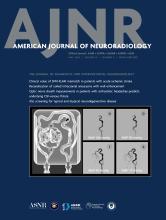This article requires a subscription to view the full text. If you have a subscription you may use the login form below to view the article. Access to this article can also be purchased.
Abstract
BACKGROUND AND PURPOSE: Spontaneous intracerebral hemorrhage is a serious stroke subtype with high mortality and morbidity. Minimally invasive surgery plus thrombolysis is a promising treatment option, but it requires accurate catheter placement and real-time monitoring. The authors introduced IV flat detector CT angiography (ivFDCTA) into the minimally invasive surgery procedure for the first time, to provide vascular information and guidance for hematoma evacuation.
MATERIALS AND METHODS: Thirty-six patients with hypertensive intracerebral hemorrhage were treated with minimally invasive surgery under the guidance of ivFDCTA and flat detector CT (FDCT) in the angiography suite. The needle path and puncture depth were planned and calculated using software on the DSA workstation. The hematoma volume reduction, operation time, complications, and clinical outcomes were recorded and evaluated.
RESULTS: The mean preoperative hematoma volume of 36 patients was 35 (SD, 12) mL, the mean intraoperative volume reduction was 19 (SD, 11) mL, and the mean postoperative residual hematoma volume was 15 (SD, 8) mL. The average operation time was 59 (SD, 22) minutes. One patient had an intraoperative epidural hematoma, which improved after conservative treatment. The mean Glasgow Outcome Scale score at discharge was 4.3 (SD, 0.8), and the mean mRS score at 90 days was 2.4 (SD, 1.1).
CONCLUSIONS: The use of ivFDCTA in the evacuation of an intracerebral hemorrhage hematoma could improve the safety and efficiency of minimally invasive surgery and has shown great potential in hemorrhagic stroke management in selected patients.
ABBREVIATIONS:
- FDCT
- flat detector CT
- HICH
- hypertensive ICH
- ICH
- intracerebral hemorrhage
- ivFDCTA
- IV FDCT angiography
- MIS
- minimally invasive surgery
- © 2024 by American Journal of Neuroradiology







